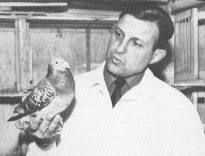Professor Alfons Anker
Hungarian professor (1925-1979), specialised in animal population
genetics.
He was not only a theoretician, he also had a large experience in
breeding new races of high yielding domestic animals. He has created
among others the world famous KA-HYB pig.
He has also applied his knowledge to his hobby: the breeding
of high quality racing pigeons. He wrote a book on this
subject with the significant title "Flying puzzles". The
task of the pigeon breeder is nothing more than that:
puzzling, solving crossword puzzles. Anker tried to fix the
rules for this game...
|

Alfons Anker |
- The genetic laws defined by Gregor
Mendel are of little help for the breeding of racing
pigeons. Most athletic properties are not inherited that way.
- Inbreeding is not a mathematical
system, it is more like playing a musical
instrument. The better the player, the better the music
that comes out of the instrument.
- Inbreeding gives the best results when
based on a superbreeder. A superracer gives
much less guarantee, because too much nonhereditary elements (like
condition, vitality) determine the racing results.
- Breeding in the family is not the same as
inbreeding. Inbreeding is always accompanied by a loss of
vitality. Anker even states that the greater the loss of
vitality, the better the effect of inbreeding. Narrowly
inbred animals are not fitted for racing, only for breeding.
- Vitality is soon regained when crossing
inbred birds. It is a very common practice in industrial
breeding of yielding animals to inbred first of all the basic
animals and then cross the products of this inbreeding. The
inbreeding is done for fixing the hereditary material; the
crossing brings the heterosis or gain of vitality and strenght.
- By inbreeding one can also fix bad qualities!
- Inbreeding is a reduction of variation. The
more a strain is inbred, the more its products will resemble one
another.
- By pairing an excellent breeder to his
children, one can obtain birds that continue to give his
excellent qualities for 10, 20 or more years. A father-daughter
or mother-son pairing is more effective for that purpose than a
brother sister combination.
(Picture of Alfons Anker: De
kunst van het kweken by Prof. Alfons Anker and Steven van
Breemen, Hilversum 1986, page 6).
|
